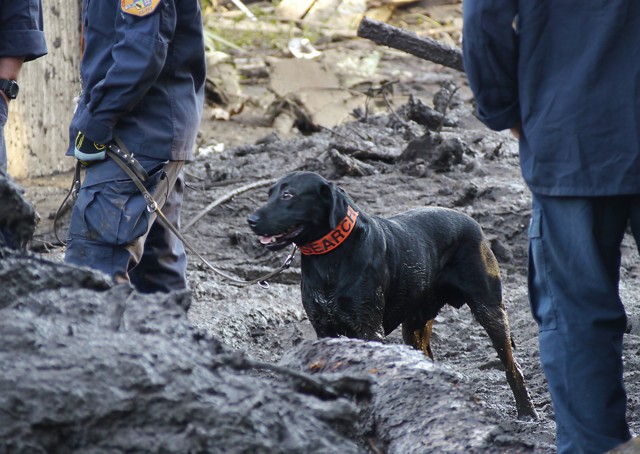Search Dogs Comb Hills of Montecito for Survivors and Remains
With at Least Three People Still Unaccounted for, 13 More Canines Assigned to Mudslide Rescue and Recovery Efforts

It’s been five days since the avalanche of mud, boulders, and rain ripped down the steep slopes of Montecito’s south-facing hillsides, burying who knows how many people in the onslaught. With every passing hour, the chances of finding survivors diminishes. Earlier this week, Sheriff Bill Brown spoke of hope and prayers when it came to finding survivors. Now he talks of miracles instead. Assigned to work such miracles are squads of highly trained search dogs, most of whom were schooled by the National Disaster Search Dog Foundation, located in Santa Paula. Of the 39 search dogs now assigned to the Montecito nightmare, 18 came from the Santa Paula training facility. Of those 39, roughly half are searching for survivors—“live finds”—in the parlance of disaster relief. No numbers are available yet as to how many survivors or remains these dogs have discovered in Montecito, but those at Incident Command agree these dogs have been invaluable. In the past two days, commanders have increased the number of dogs assigned to Montecito from 26 to 39.
“We go out in the debris flow — with all the mud and piles of rubble — and if we don’t find anyone there, any survivors, then that means we can go on and focus our resources elsewhere,” explained San Diego firefighter Brent Brainard, who has been working the canine search-and-rescue detail for the past nine years. If Brainard’s dog Decker, a 7-year-old lab-Weimaraner mix, doesn’t smell anyone alive, it’s all but certain no one’s there to be found. To make sure, however, a second dog — specially trained to detect only living survivors — checks the same area. If both dogs find nothing, that allows search-and-rescue teams to focus their efforts elsewhere.
Brainard and Decker work 12-hour shifts. Much of that time, Decker is up to his chest in mud. It’s slow, painstaking work. Swimming pools pose hidden threats; one false step, and rescue workers can sink to the bottom of the deep end before they know it. That’s happened at least once; the firefighter was quickly rescued. To date, Decker has found no survivors. As Brainard explained things, it’s his job to take good care of his dog. That includes maintaining Decker’s morale. “He wants to find someone. That’s what he’s trained to do,” Brainard explained. To this end, Brainard said he’ll arrange to have Decker “find” someone, a fellow rescuer that has been hidden away for just such purposes.
Decker is one of 192 dogs trained by the National Disaster Search Dog Foundation since 1996, when the private, nonprofit organization first opened shop. According to center spokesperson Denise Sanders, rescue dogs are trained for about 8-10 months. When they’re done, they can tell the difference between a live body and a dead body. They can also tell the difference between a live body and fresh clothes. “You go into some of these houses, and you have clothes, diapers, stuffed animals — all these different things that carry the scent of people who may be missing,” Sanders explained. “Our dogs have to be able to tell them apart.”
Many of the dogs now working Montecito are specially trained only to detect dead bodies. They are known either as “cadaver dogs” or “HR” dogs, HR standing for “human remains.” Most of these dogs are trained using food as a reward rather than toys. Sanders said that these dogs are specially trained to find only body parts or the intact remains of a deceased human being. For their training, real human body parts are used, acquired from a facility in Tennessee that studies the process of decomposition of deceased human beings. Sanders also said human placentas are used in training HR dogs.
Typically, the school’s recruits are rescue dogs themselves, mutts whose focus, energy, and manic obsession when it comes to toys make them terrible pets. “They have to have an obsessive intensity when it comes to owning certain toys that borders on dysfunctional,” she said. Trainers harness that focus, using it as a tool to reward search dogs for successful work. The toys, she said, are typically very rugged chew toys, made of old fire hoses encased in thick hardy material. Once trained “live find” dogs pick up a scent, they get up as close as they can and then bark nonstop. At that point, handlers like Brainard show up, mark the spot, and direct rescue workers to begin excavation. It’s at that time, however incongruous, they reward the dog by playing with it. “It sounds strange but that’s how they’re motivated,” Sanders said. Toys are used as a reward rather than food, Sanders explained, for logistical reasons. “What happens if they’re out there and they come across the contents of a spilled refrigerator?”
Brainard is now on his second rescue dog. He and Decker live together 24/7. Decker fits the manic profile of rescue dogs, Brainard said. By the time the two got together, Decker had been “surrendered” by two previous owners. In one case, there had been a divorce. In the second, Decker just wore out the owner by his incessant energy. Brainard, who has a pet dog too, said it hasn’t been a problem. Speaking of Decker, he said, “He’s got the greatest personality, and he’s the best partner anyone could have.”
The two of them work search-and-rescue operations in San Diego, but when disaster strikes, they hit the road. They worked hurricanes Harvey and Irma last year, but to date, Decker has yet to make a live find.
Sanders herself is no stranger to Santa Barbara or natural disaster. She worked as a dispatcher for the Santa Barbara County Sheriff’s Office from 2002 to 2008. The foundation’s 125-acre compound in Santa Paula had been open for business just two months when the Thomas Fire struck. That fire destroyed five acres of the foundation’s training grounds, including a model city known as “Rescue City.” A practice rubble pile survived, as did a practice train car, but trainers and dogs were forced to evacuate for no less than 18 days.
The foundation was the brainchild of Ojai resident Wilma Melville, who, in the wake of the Oklahoma City bombing in 1995, concluded there was a dearth of skilled rescue dogs for such disasters. “Wilma’s a little like the dogs we train,” Sanders laughed. “She has unstoppable energy and determination.” Over time, she said, the foundation has trained 192 dogs and now has 69 teams dispatched throughout the country. Melville has sought to create a training grounds that replicates some of the most challenging environments rescue dogs are likely to confront. “Our biggest test was in 2010 with the earthquake in Haiti,” Sanders said. “There you had buildings that were five to seven stories tall that collapsed in on themselves. They just pancaked. Our dogs could detect live scents underneath all that.”



